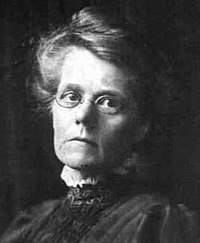Alicia Boole Stott
Alicia Boole Stott | |
|---|---|
 | |
| Born | 8 June 1860 |
| Died | 17 December 1940 (aged 80) Middlesex, England |
| Citizenship | British |
| Known for | Mathematics |
| Parents |
|
Alicia Boole Stott (8 June 1860 – 17 December 1940)
Personal life
Alicia Boole was born in
After her father's sudden death in 1864, the family moved to London, where her mother became the librarian at Queen's College, London.[4] Alicia attended the school attached to Queens' College with one of her sisters, but never attended university. She was known to her friends and family as Alice, though she always published under the name Alicia.
Career
Early
Alicia was the only Boole sister to inherit the mathematical career of her parents, although her mother Mary Everest Boole had brought up all of her five children from an early age "to acquaint them with the flow of geometry" by projecting shapes onto paper, hanging pendulums etc.
Late
After taking up secretarial work near
The University of Groningen honoured her by inviting her to attend the tercentenary celebrations of the university and awarding her an honorary doctorate in 1914.[9] After Schoute's death in 1913 Alicia took a hiatus from mathematical work.
In 1930 she was introduced by her nephew Geoffrey Ingram Taylor to Harold Scott MacDonald Coxeter and they worked together on various problems.[9] Alicia made two further important discoveries relating to constructions for polyhedra related to the golden section. She presented a joint paper with Coxeter at the University of Cambridge.[4] Coxeter later wrote, "The strength and simplicity of her character combined with the diversity of her interests to make her an inspiring friend."[3]
Death and legacy
Alicia died in Middlesex in 1940.[9] In spring 2001, a paper roll of coloured drawings of polyhedra was found at Groningen University.[4] Though unsigned, it was immediately recognised as Alicia's work. It led to research by Irene Polo-Blanco, who dedicated a chapter to Alicia's work in her book Theory and History of Geometric Models (2007). The pioneering spirit of grandfather and mother continued in her son Leonard, who assisted in tuberculosis treatment and invented an artificial pneumothorax apparatus.[10]
Citations
- ^ Riddle, Larry, "Alicia Boole Stott", Biographies of Women Mathematicians, Agnes Scott College
- ^ Greenwood Press. pp. 243–245.
- ^ a b Coxeter 1973, pp. 258–259.
- ^ ISBN 9780953195312.
- ISBN 978-1782051855
- ^ Coxeter 1973, p. vi, Preface to the first edition.
- .
- ^ W. W. Rouse Ball (1960) Mrs. Stott's Construction, in Mathematical Recreations and Essays, Macmillan, New York, pp 139–140.
- ^ a b c Franceschetti, Donald R. (1999). "Biographical Encyclopedia of Mathematicians – Vol. 2". Marshall Cavendish. pp. 482–484. Archived from the original on 4 March 2016.
- doi:10.1090/noti1996.
References
- Coxeter, H.S.M. (1973) [1948]. Regular Polytopes (3rd ed.). New York: Dover.
External links
- O'Connor, John J.; Robertson, Edmund F., "Alicia Boole Stott", MacTutor History of Mathematics Archive, University of St Andrews
- "Alicia Boole Stott, the woman who could see four dimensions - Moira Chas". YouTube. Stony Brook Mathematics. 4 October 2020.
Publications
- A. Boole Stott: Geometrical deduction of semiregular from regular polytopes and space fillings, Verhandelingen van de Koninklijke Akademie van Wetenschappen, Verhandelingen Natuurkunde, Eerste Sectie, deel 11, nummer 1 (1910), 1–24. Amsterdam, 1910.
- All publications by A. Boole Stott (as an author and as a co-author) with the Koninklijke Akademie van Wetenschappen
